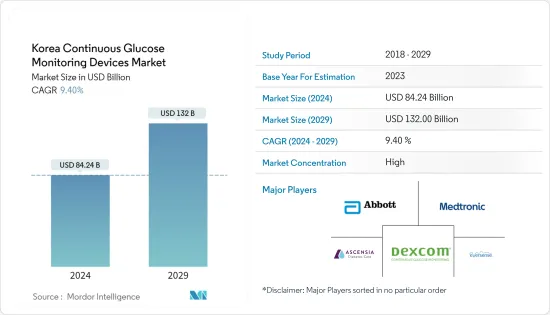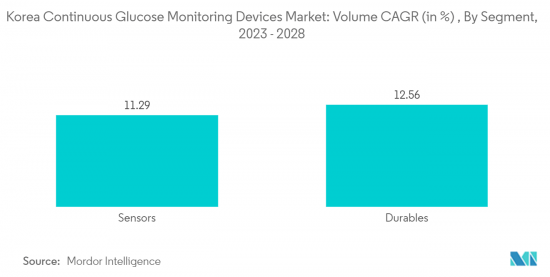
한국의 연속 혈당 모니터링 기기 시장 규모는 2024년 842억 4,000만 달러로 추정되며, 2029년에는 1,320억 달러에 달할 것으로 예상되며, 예측 기간(2024-2029년) 동안 9.40%의 CAGR을 기록할 것으로 예상됩니다.

당뇨병은 COVID-19 환자의 사망 위험 및 심각한 임상결과와 밀접한 관련이 있는 주요 동반질환 중 하나입니다. 여러 역학 연구 결과에 따르면, 심각한 임상 경과를 보이는 COVID-19 환자에서 당뇨병의 비율이 높고, 당뇨병 환자는 비당뇨병 환자보다 COVID-19 감염에 더 취약한 것으로 일관되게 보고되었습니다.
팬데믹 기간 동안 의료진과 당뇨병 환자들은 접촉을 최소화하고 격리해야 했고, 원격의료는 급성 합병증 예방과 중증 고혈당 조절에 있어 대체적인 지원을 제공했습니다. 최적의 혈당 조절을 유지하도록 권고했습니다.
CGMS의 주요 사용 대상은 인슐린 치료를 받고 있는 제1형 또는 중증 제2형 당뇨병 환자입니다. 인슐린 의존형 당뇨병 환자가 SBGM에 의존하는 경우, 하루에 최대 10회까지 바늘로 손가락을 찔러 혈액을 채취하여 혈당을 측정하고 상황에 따라 고혈당 쇼크나 저혈당 쇼크를 피하기 위해 인슐린을 주사해야 합니다. 반면 CGMS 사용자는 한 번의 센서 삽입으로 1-7일 동안 추가 채혈 없이 혈당 변화를 모니터링할 수 있습니다.
시장 조사를 추진하는 주요 요인은 당뇨병 유병률의 증가와 한국 정부의 지원 이니셔티브입니다.
센서의 송신기는 혈당 측정값을 판독기, 수신기 또는 스마트폰 앱에 전달하는 역할을 합니다. 수신기로 알려진 장치는 송신기로부터 데이터를 수집하고 그 결과를 다양한 사용자 인터페이스에 표시하는 역할을 합니다. 제조업체에 따르면 다양한 CGM 장치의 구성요소는 서로 다른 방식으로 작동합니다. 이 가제트는 피부에 부착해야하며 때로는 눈에 보일 수도 있습니다. 송신기의 배터리는 일회용 및 충전식 배터리가 있습니다. 당뇨병 환자의 CGM 장치 사용률 증가, 당뇨병의 근본 원인 증가, 시장에서의 제품 가용성, 이러한 내구성 소비재의 장점, CGM 장치 사용에 대한 일본 소비자의 인식이 높아짐에 따라 시장 분야가 확대될 것으로 예상됩니다.
한국의 NHIS는 한국 정부가 관리하는 단일 강제 의료보험제도로, 한국의 거의 모든 국민에게 의료 서비스를 제공하고 있습니다. 한국의 NHIS 데이터베이스에는 사회 인구 통계학적 정보, 의료 서비스 이용, 의료 청구, 건강 검진 등이 포함되어 있습니다. 한국인은 소모품이든 CGMS든 보험 환급을 요구하기 전에 NHIS에 제1형 당뇨병 환자로 등록해야 합니다. 환자는 하루나 이틀 후 국민건강보험공단 콜센터에 전화하면 확인이 가능하지만 주치의가 대신해 주며, CGM 내구소비재 환급을 신청하려면 한국인은 약값 환급 신청서, 처방전, 현금영수증, 거래명세서 등이 필요했습니다.
당뇨병 유병률 증가, 공공 및 민간 단체의 이니셔티브 증가 등의 요인으로 인해 예측 기간 동안 이 나라의 시장 성장이 증가할 것으로 예상됩니다.

한국의 제 1형 당뇨병 인구는 예측 기간 동안 연평균 0.35% 이상 증가할 것으로 예상됩니다.
제1형 당뇨병과 제2형 당뇨병은 모두 혈중 포도당(당) 농도가 높은 것이 특징인 만성 질환입니다. 인슐린 의존성 당뇨병으로도 알려진 제1형 당뇨병은 췌장의 인슐린 생산 세포에 대한 자가 면역 공격으로 인해 인슐린 생산이 완전히 결핍되어 발생하는 질환으로, 원인, 증상, 위험 요인이 다릅니다. 보통 소아기나 성인 초기에 발병하며 매일 인슐린 주사를 맞아야 관리할 수 있습니다. 반면 제2형 당뇨병은 인슐린 저항성(인체가 인슐린을 효과적으로 사용할 수 없는 상태)과 인슐린 생산 감소가 결합되어 발생합니다. 보통 식습관 장애, 운동 부족, 비만 등 생활습관과 관련이 있으며, 성인에게 많이 나타납니다. 식이요법, 운동 등 생활습관 개선으로 관리할 수 있는 경우가 많지만, 일부 제2형 당뇨병 환자들은 약물치료나 인슐린 요법이 필요한 경우도 있습니다. 두 가지 유형의 당뇨병 모두 제대로 관리하지 않으면 심각한 건강 합병증을 유발할 수 있습니다.
2022년 1월, 한국의 의료기기 시장 규제 기관인 식품의약품안전처(MFDS)는 한국의 의료기기법 일부 개정안을 시행할 예정이며, 전자적 사용 적응증 대상 기기 목록도 확대할 예정입니다. 한국 시장에서 원격 환자 모니터링 기기의 보급은 현지 임상 연구 기관(CRO)의 임상 연구 시험을 지원하고 모니터링의 용이성을 보장함으로써 발견 과정을 촉진할 수 있습니다.
당뇨병은 한국에서 가장 흔한 만성 질환 중 하나입니다. 따라서, 당뇨병 유병률의 증가는 예측 기간 동안 연속 혈당 모니터링의 채택을 증가시키고 시장 성장을 증가시킬 것으로 예상됩니다.
한국의 연속 혈당 모니터링 기기 시장은 고도로 통합되어 있으며, Dexcom, Abbott, Medtronic과 같은 시장 리더들은 시장에서의 발판을 마련하기 위해 제품 출시 및 기술 제휴에 주력하고 있습니다.

The Korea Continuous Glucose Monitoring Devices Market size is estimated at USD 84.24 billion in 2024, and is expected to reach USD 132 billion by 2029, growing at a CAGR of 9.40% during the forecast period (2024-2029).
Diabetes was one of the main comorbidities closely related to the risk of mortality and severe clinical outcomes in patients with COVID-19. Numerous epidemiological findings consistently suggested that the proportion of diabetes was higher in COVID-19 patients with a severe clinical course and that people with diabetes were also more vulnerable to COVID-19 infection than those without diabetes.
During the pandemic, health providers or diabetic patients were required to minimize contact and quarantine, and telehealth provided alternative support in preventing acute complications and controlling severe hyperglycemia. People with diabetes who were not infected with the SARS-CoV-2 were also recommended to maintain optimal glycemic control as part of the primary prevention of COVID-19.
The primary use of CGMS is for patients with type 1 or severe type 2 diabetes who are on insulin therapy. If insulin-dependent diabetics are dependent on SBGM, they should prick their fingers with needles up to 10 times a day to draw blood to measure blood glucose and, depending on the situation, inject insulin to avoid hyperglycemic or hypoglycemic shock. On the other hand, CGMS users can monitor their blood glucose changes for 1-7 days without any additional blood draw with a single sensor insertion.
The key factors propelling the market studied are increasing diabetes prevalence and the support initiatives taken by the Korean government.
A sensor's transmitter is what communicates blood glucose readings to a reader, receiver, or smartphone app. Devices known as receivers are those that collect data from transmitters and present the results on various user interfaces. According to the manufacturer, various CGM device components operate differently. These gadgets may need to be applied to the skin and are sometimes visible. Both disposable and rechargeable transmitter batteries are available. The market sector is anticipated to expand as a result of rising CGM device usage among diabetics, rising underlying causes of diabetes, market product availability, benefits of these durables, and increased awareness of CGM device use among Japanese consumers.
Korean NHIS is a single, compulsory health insurance system managed by the Korean government, providing healthcare coverage to almost the entire Korean population. The Korean NHIS database includes sociodemographic information, the use of medical services, medical claims, and health examinations. Koreans must register with NHIS as Type 1 Diabetics before requesting any insurance rebates, whether for consumables or CGMS. The patient can simply confirm this a day or two later by calling the NHI call center, but the patient's doctor will be able to do that for them. In order to apply for a refund for CGM Durables, Koreans needed an NHI refund form, prescription, cash receipt, and transaction statement.
Factors such as the increasing prevalence of diabetes, coupled with the increasing initiatives by public and private organizations, are expected to increase market growth in the country over the forecast period.

The Type 1 diabetes population in Korea is expected to increase at a CAGR greater than 0.35% over the forecast period.
Type 1 diabetes and Type 2 diabetes are both chronic diseases characterized by high levels of glucose (sugar) in the blood. However, they differ in their causes, symptoms, and risk factors. Type 1 diabetes, also known as insulin-dependent diabetes, is caused by an autoimmune attack on the insulin-producing cells in the pancreas, leading to a complete lack of insulin production. It typically develops in childhood or early adulthood and requires daily injections of insulin to manage. Type 2 diabetes, on the other hand, is caused by insulin resistance (when the body can't effectively use insulin) combined with a decrease in insulin production. It is usually linked to lifestyle factors such as poor diet, lack of physical activity, and obesity and is more common in adults. It can often be managed through lifestyle changes such as diet and exercise, although some people with type 2 diabetes may also need medication or insulin therapy. Both types of diabetes can lead to serious health complications if not properly managed.
In January 2022, the Ministry of Food and Drug Safety (MFDS), South Korea's medical device market regulator, planned to roll out several amendments to the country's Medical Devices Act and has also expanded its list of devices eligible for electronic indications for use. Penetration of remote patient monitoring devices in the South Korean market supports local clinical research organizations (CROs) in their clinical research trials and ensures ease of monitoring, which facilitates the discovery process.
Diabetes is one of the country's most prevalent chronic diseases. Thus, the increasing prevalence of diabetes is expected to increase the adoption of continuous glucose monitoring in the country, which is expected to increase market growth over the forecast period.
The Korean continuous glucose monitoring devices market is highly consolidated. Market leaders such as Dexcom, Abbott, and Medtronic are focusing on product launches and technological collaborations to increase their foothold in the market.